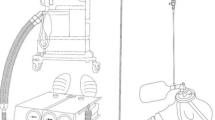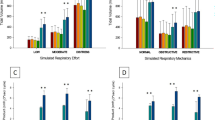Abstract
Objectives
To measure the extent of dilution of helium-oxygen (heliox) by room air when given via high concentration reservoir mask to spontaneously breathing subjects. Substantial dilution of heliox by room air under these circumstances might alter its physical properties sufficiently to negate any potential clinical benefit in obstructive respiratory failure.
Design
Healthy volunteers breathing different concentrations of helium in oxygen via two different masks in a randomised crossover design.
Setting
Operating theatre in a university hospital.
Patients and participants
Six healthy volunteers.
Interventions
The concentrations of helium, nitrogen and oxygen were measured in the trachea of each volunteer using a mass spectrometer during normal breathing, hyperventilation and hypoventilation.
Measurements and results
During normal breathing of Heliox21 (79% helium) via a standard non-rebreathe reservoir mask, within subject median percentage tracheal helium was 37.2% (range 29.3–52.2%) and nitrogen was 41.7% (27.4–49.4%). Air entrainment was affected by changes in breathing pattern: tracheal nitrogen concentration was greater during hyperventilation (55.4%; range 49.4–63.5%) and less during hypoventilation (33.1%; range 24.6–39.6%, p = 0.043). Tracheal nitrogen could be almost completely abolished by administering heliox via a tightly fitting cushioned facemask, even during hyperventilation (2.2%; range 0.6–6.1%, p = 0.028).
Conclusions
Heliox administration via a standard high-concentration reservoir mask leads to significant dilution by room air. For the full potential benefits of heliox to be realised in spontaneously breathing patients, it should be administered via a system that achieves a gas tight seal, with no leaks between the delivery device and the surroundings.



Similar content being viewed by others
References
Barach A (1934) Use of heliox as a new therapeutic gas. Proc Soc Exp Biol Med 32:462–464
Ball JAS, Rhodes A, Grounds RM (2001) A review of the use of helium in the treatment of acute respiratory failure. Clin Intensive Care 12:105–113
Corcoran TE, Gamard S (2004) Development of aerosol drug delivery with helium oxygen gas mixtures. J Aerosol Med 17:299–309
Hess DR, Fink JB, Venkataraman ST, Kim IK, Myers TR, Tano BD (2006) The history and physics of heliox. Respir Care 51:608–612
Barach A (1936) The therapeutic use of helium. J Am Med Assoc 107:1273–1275
Heuer AJ, Scanlan CL (2003) Medical gas therapy. In: Wilkins RL, Stoller JK, Scanlan CL (eds) Egan’s fundamentals of respiratory care. Mosby, St. Louis, pp 827–861
Boumphrey SM, Morris EA, Kinsella SM (2003) 100% inspired oxygen from a Hudson mask: A realistic goal? Resuscitation 57:69–72
Morris EA, Smith AJ, Kinsella SM (2001) Performance of standard and reservoir-type Hudson masks in pregnant and non-pregnant subjects. Int J Obstet Anesth 10:284–288
Murciano D, Aubier M, Viau F, Bussi S, Milic-Emili J, Pariente R, Derenne JP (1982) Effects of airway anesthesia on pattern of breathing and blood gases in patients with chronic obstructive pulmonary disease during acute respiratory failure. Am Rev Respir Dis 126:113–117
Drazen JM, Loring SH, Ingram RH Jr (1976) Distribution of pulmonary resistance: effects of gas density, viscosity, and flow rate. J Appl Physiol 41:388–395
Rodrigo G, Pollack C, Rodrigo C, Rowe BH (2006) Heliox for nonintubated acute asthma patients. Cochrane Database Syst Rev 4:CD002884
Rodrigo GJ, Rodrigo C, Pollack CV, Rowe B (2003) Use of helium–oxygen mixtures in the treatment of acute asthma: a systematic review. Chest 123:891–896
Ho AM, Lee A, Karmakar MK, Dion PW, Chung DC, Contardi LH (2003) Heliox vs air–oxygen mixtures for the treatment of patients with acute asthma: a systematic overview. Chest 123:882–890
Rodrigo G, Pollack C, Rodrigo C, Rowe B (2002) Heliox for treatment of exacerbations of chronic obstructive pulmonary disease. Cochrane Database Syst Rev 2:CD003571
Reuben AD, Harris AR (2004) Heliox for asthma in the emergency department: a review of the literature. Emerg Med J 21:131–135
Andrews R, Lynch M (2004) Heliox in the treatment of chronic obstructive pulmonary disease. Emerg Med J 21:670–675
Wigmore T, Stachowski E (2006). A review of the use of heliox in the critically ill. Crit Care Resusc 8:64–72
Myers TR (2006) Use of heliox in children. Respir Care 51:619–631
Colebourn CL, Barber V, Young JD (2007) Use of helium–oxygen mixture in adult patients presenting with exacerbations of asthma and chronic obstructive pulmonary disease: a systematic review. Anaesthesia 62:34–42
Barach A (1935) The use of helium in the treatment of asthma and obstructive lesions of the larynx and trachea. Ann Intern Med 9:739–765
Kass JE (2003) Heliox redux. Chest 123:673–676
Dhuper S, Choksi S, Selvaraj S, Jha G, Ahmed A, Babbar H, Walia B, Chandra A, Chung V, Shim C (2006) Room air entrainment during beta-agonist delivery with heliox. Chest 130:1063–1071
Kress JP, Noth I, Gehlbach BK, Barman N, Pohlman AS, Miller A, Morgan S, Hall JB (2002) The utility of albuterol nebulized with heliox during acute asthma exacerbations. Am J Respir Crit Care Med 165:1317–1321
Kass JE, Terregino CA (1999) The effect of heliox in acute severe asthma: a randomized controlled trial. Chest 116:296–300
Lee DL, Hsu CW, Lee H, Chang HW, Huang YC (2005) Beneficial effects of albuterol therapy driven by heliox versus by oxygen in severe asthma exacerbation. Acad Emerg Med 12:820–827
Broeders ME, Molema J, Hop WC, Vermue NA, Folgering HT (2004) The course of inhalation profiles during an exacerbation of obstructive lung disease. Respir Med 98:1173–1179
Shim CS, Williams MH Jr (1983) Relationship of wheezing to the severity of obstruction in asthma. Arch Intern Med 143:890–892
Gainnier M, Arnal JM, Gerbeaux P, Donati S, Papazian L, Sainty JM (2003). Helium–oxygen reduces work of breathing in mechanically ventilated patients with chronic obstructive pulmonary disease. Intensive Care Med 29:1666–1670
Tassaux D, Jolliet P, Roeseler J, Chevrolet JC (2000) Effects of helium–oxygen on intrinsic positive end-expiratory pressure in intubated and mechanically ventilated patients with severe chronic obstructive pulmonary disease. Crit Care Med 28:2721–2728
Schaeffer EM, Pohlman A, Morgan S, Hall JB (1999) Oxygenation in status asthmaticus improves during ventilation with helium–oxygen. Crit Care Med 27:2666–2670
Jolliet P, Tassaux D, Roeseler J, Burdet L, Broccard A, D'Hoore W, Borst F, Reynaert M, Schaller MD, Chevrolet JC (2003) Helium–oxygen versus air–oxygen noninvasive pressure support in decompensated chronic obstructive disease: a prospective, multicenter study. Crit Care Med 31:878–884
Eves ND, Petersen SR, Haykowsky MJ, Wong EY, Jones RL (2006) Helium-hyperoxia, exercise, and respiratory mechanics in chronic obstructive pulmonary disease. Am J Respir Crit Care Med 174:763–771
Palange P, Valli G, Onorati P, Antonucci R, Paoletti P, Rosato A, Manfredi F, Serra P (2004) Effect of heliox on lung dynamic hyperinflation, dyspnea, and exercise endurance capacity in COPD patients. J Appl Physiol 97:1637–1642
Richardson RS, Sheldon J, Poole DC, Hopkins SR, Ries AL, Wagner PD (1999) Evidence of skeletal muscle metabolic reserve during whole body exercise in patients with chronic obstructive pulmonary disease. Am J Respir Crit Care Med 159:881–885
Laude EA, Duffy NC, Baveystock C, Dougill B, Campbell MJ, Lawson R, Jones PW, Calverley PM (2006) The effect of helium and oxygen on exercise performance in chronic obstructive pulmonary disease: a randomized crossover trial. Am J Respir Crit Care Med 173:865–870
Marciniuk DD, Butcher SJ, Reid JK, MacDonald GF, Eves ND, Clemens R, Jones RL (2007) The effects of helium–hyperoxia on 6-min walking distance in COPD: a randomized, controlled trial. Chest 131:1659–1665
Johnson JE, Gavin DJ, Adams-Dramiga S (2002) Effects of training with heliox and noninvasive positive pressure ventilation on exercise ability in patients with severe COPD. Chest 122:464–472
Acknowledgements
The University Division of Anaesthesia was supported by an unrestricted educational grant from BOC Medical Ltd. BOC Medical Ltd did not have any role in the study design, in collection, analysis, and interpretation of data, in the writing of the paper, or in the decision to submit the paper for publication. We are grateful to J.G. Jones and to the Departments of Clinical Engineering and Lung Function at Addenbrooke’s Hospital, Cambridge, for their invaluable help and advice. The work was supported by an unrestricted educational grant from BOC Medical Ltd, UK.
Author information
Authors and Affiliations
Corresponding author
Additional information
An erratum to this article can be found at http://dx.doi.org/10.1007/s00134-008-1341-z
Rights and permissions
About this article
Cite this article
Standley, T.D.A., Smith, H.L., Brennan, L.J. et al. Room air dilution of heliox given by facemask. Intensive Care Med 34, 1469–1476 (2008). https://doi.org/10.1007/s00134-008-1064-1
Received:
Accepted:
Published:
Issue Date:
DOI: https://doi.org/10.1007/s00134-008-1064-1




